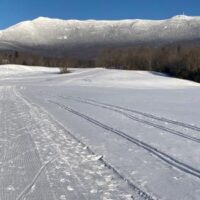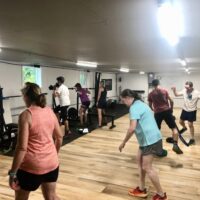It has been a busy year of testing and racing on fluoro-free products.
Many days are testing days…regular training session? Put two different waxes on and try them! Race day? At VT Cup #3 in Woodstock I went back through the notes to calculate that we tested a total of 36 different NF topcoats and combinations.
Ski waxing is a game of narrowing choices. Think about how many kickwaxes skiers often own: usually enough tins to fit into a small shopping bag, and that’s not even putting klister into the mix. Over plenty of time we’ve gotten pretty darn good at narrowing down our choices on a given day.
For training, we can toss on something of a good guess and have skis suitable for our workout. On race days in stable conditions, we can pick a good starting point of 4 options out of the unfathomable possibilities.
As we go forward into 2021 and beyond, glide waxing is becoming more similar to kick waxing in terms of being a multi-step, multi-layer, multi-method process. Before fluoros were out, we were on a very simple system of applying a neutral, hard and wide-ranging LF layer. This was followed-up with the liquid HF layer in a representative temp and snowtype. Finally, fluoro topcoats were tested.
Now, each respective layer has much more impact. Below is a diagram I created to represent what we’re going for. Both pyramids reach the same height, but the NF pyramid requires a broader base and more steps to get to the same level of performance. Note that this pyramid is ONLY taking into account wax, and not ski selection, base material, grinds, or hand structure.

So…which waxes fit into these categories? Right now, opening the MNC wax box is akin to dumping out the tacklebox of a lifelong fisherman (thought slightly more organized, for sure). For paraffins and underlayers, things look similar to what we’ve seen in the past, although these are only NF options. You may recognize some familiar companies, as well as some “underground” manufacturers. We’ve been testing them all!

Iron-on paraffins that we like and have seen success with: Rode line in all conditions, as well as the Star and Briko lines in warmer conditions. The SkiGo Green has been great in cold, and we saw great success with the Swix Pro Marathon Clean Snow…so much so that we are currently out of it and you’ll only notice the “Dirty Snow” variant here.
When we refer to graphite as an “underlayer” this means it’s the first thing applied to all skis. We test this by making two skis…one ski has graphite, scraped and brushed, followed by a paraffin like Toko Red, scraped and brushed. The second ski has the paraffin like Toko Red, scraped and brushed, followed by another layer of Toko Red, scraped and brushed. This lets you know if the graphite is having an effect on the paraffin that follows it. There is an excellent write-up of graphite ski waxes at this link.
Now on to the part more people are probably curious about, and the biggest “unknown” right now that every team, international teams included, are trying to learn about…fluoro free “topcoats”.
We define topcoats as a race-day application, usually applied within an hour to the start of the race. While we try to test paraffin and underlayers the day before a race (if conditions are looking similar on consecutive days) we will test NF topcoats as much and as late into the game as possible. While some of these products, like CH10X Spray or Rex G41, are technically just paraffins in liquid form, their quickness of application means we treat them as a viable final layer.
Liquid Topcoats
The big difference in liquids from various brands are the drying times. You want a liquid that dries FAST because a dry liquid means it has evaporated all of the solvent and reached maximum effectiveness.
The liquids that dry fast are: Rode, Vauhti, Star, Rex, and Start
The liquids that dry slowly are: Toko, Swix, Holmenkol
Some liquids are best when dried and polished with nylon. Some prefer to be brushed with metal. Others can really see a speed boost when they’re “fluffed” (as we say) with the wool roto-fluffer…more on that below.
Successful liquids we really like: All Rode liquids. Swix CH10X in slushy snow. Rex G41 in manmade snow at all temps. Start RG Graphite in new-falling snow. Start RG Violet in general mid-range temps. Toko BP Blue in colder natural snow. Vauhti LDR in certain transforming natural snow.

Life-hack: store your liquids in a toolbox arranged UPRIGHT to avoid any leakage
Powder Topcoats
Powders aren’t the fastest to apply, but they generally cool down in less time than an ironed paraffin and they can be viable race-day solutions. They sort of walk the line between a paraffin layer and a topcoat layer.
Successful powders we really like: Star Med powder which runs in a wide range from the 20s to the mid-30s. Vauhti LDR powder in transformed natural snow. Solda S-20 in dry, grainy snow.

Wool Topcoats
Definitely the most intriguing and unique option of the topcoats. Wool topcoats are applied in a unique fashion with a fancy-and-funny-looking lambswool roto device which we colloquially refer to as a “fluffer”.
Wool products go on fast, you can layer them easily (our standard procedure is to do 2 layers as one “app”) and they seem to last a loooong time. We aren’t going to run out of any of our wool products anytime soon and they are extremely cost-effective per use.
All you do is run an almost imperceptible-thin layer onto the ski, or right onto the wool fur, and then buff the ski. Next, hit with a horsehair brush one time before a second application and a second quick brush. Done! These waxes are prime for layering and mixing given the way they behave.

Wool products we really like: Ulla Black for transforming cold snow. Ulla Grey and YES Green for new cold snow. Star Med and Warm for general mid-range conditions, with Warm handling new-falling snow very well. The secret of Ulla Red/Black got out last year, as it’s the real weapon in manmade and dirty snow.
Want to see a video from Zach Caldwell all about wool waxes? Look no further:



